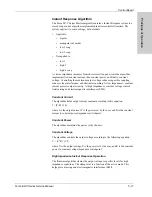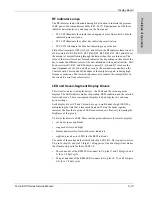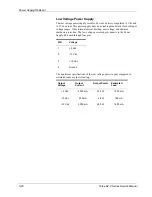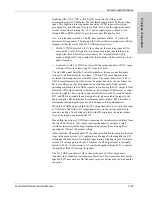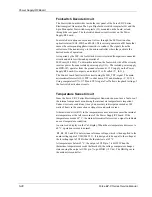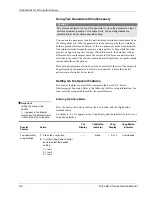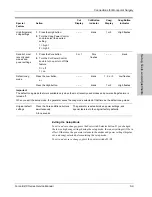
Power Supply/RF Board
Principles of Operation
Force EZ-C Series Service Manual
5-23
Cut Modes
In the cut modes, the K1 setting allows the following conditions:
•
diode CR7 is in parallel with the MOSFET body drain diode
•
C62 and C65 are across the MOSFET
•
the transformer primary consists of windings 1-2 and 3-4 in series
K15 is closed so the series capacitor bank (C143, C154, C159, C165, and C166) is
across the output.
In the pure cut mode, the T_ON\ signal is a continuous pulse train with a
frequency of 393 kHz. In this case, essentially two resonant circuits operate in
tandem. The output L-C filter is tuned just slightly higher than the RF switching
frequency, achieving a high degree of filtering. The output is very sinusoidal over
the full range of load impedances. Capacitors C62 and C65 are tuned with the RF
transformer primary so that the flyback voltage appearing across the MOSFET at
turn off is a half sine pulse and returns to zero volts before the next cycle begins.
The T_ON\ pulse width is chosen to support this tuning. This zero voltage
switching improves the efficiency of the RF stage and is effective over a wide
range of load impedances.
The circuit topology of the blend cut mode is the same as the pure cut mode. In
blend mode, however, the T_ON\ signal is an interrupted pulse train with a 50%
duty cycle and a frequency of 27.1 kHz. For a given power setting, blend gives a
higher peak current, providing better hemostasis than pure. To minimize ringing
at the beginning of the off period of the blend waveform envelope, the damping
resistor switches on just before switching ends and stays on for part of the off
period.
Coag Modes
In the high 1 (fulgurate) setting, the K1 setting allows these conditions:
•
diode CR7 blocks reverse current in the power MOSFET
•
C100 as well as C62 and C65 are across the MOSFET
•
the transformer primary consists of winding 1-2 only
K15 is open, keeping the series capacitor bank (C143, C154, C159, C165, and
C166) out of the circuit.
The T_ON\ signal is a continuous pulse train with a pulse width of 1.69 µs and a
frequency of 57 kHz. When the MOSFET turns on, some energy goes to the
output and some goes to storage in the T4 core. When the MOSFET turns off, the
energy stored in the core rings out with a nominal frequency of 470 kHz. C62,
C65, C100 and the inductance of winding 1-2 of T4 set the frequency. CR7 blocks
reverse current in the body drain diode of the MOSFET so that the power
waveform can ring negative. This allows high peak voltages at the output. In most
cases, the system delivers all the energy stored in the transformer core during one
switching cycle to the load before the next cycle begins.
To minimize ringing on the output voltage waveform at light loads, transistor Q8
switches in the 50 watt, 50 ohm heat sink mounted resistor in series with the
transformer primary for part of the RF switching cycle.



